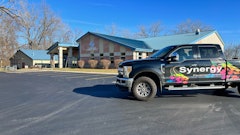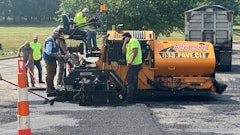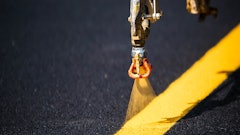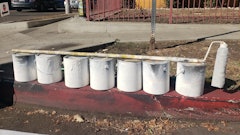
Pavement markings are installed to keep pilots, motorists, and pedestrians safe. The need for safety increases even more at night. One way contractors can increase the visibility of pavement markings is with glass beads. "High index of refraction glass bead products afford drivers to have continuous delineation, increased preview distance, and amplified roadway contour vision," says Kevin Hall, technical service representative for Potters Industries Inc.
Glass beads have been used in pavement markings for years and have become mainstream and often mandatory in some places. The beads - embedded in the liquid binder - bend light, and that combination creates retroreflectivity of the pavement markings. This retroreflective light is reflected back to the viewer, making the markings easier to see. Another benefit: the glass beads can be made out of recycled glass.
These beads are most often used on crosswalk intersections, highway, and airport markings, says Abe Martinez, manager for Mar-Don LLC. Although they are not required for parking lot or private commercial markings, Martinez says it's an option all contractors should offer their customers.
The Application Process
Contractors adding glass beads to their marking application can choose from several kinds and sizes of glass beads. Aside from the standard glass beads, contractors can also purchase direct melt glass beads which are crystal clear or high index glass beads which have a higher index of refraction than standard glass beads, Hall says.
Generally, for reflection, the bigger the bead the more reflection you'll get, Martinez says. Often, the size of the glass beads is specified by a governing agency.
Years ago, glass beads needed to be applied by hand. A crew member would use a striping or thermoplastic unit to apply the pavement marking. A second crew member would follow behind broadcasting the beads over the just applied marking.
With this method it's possible for the beads to be spread over parts of the pavement where there is no liquid binder. With nothing to embed in, the beads are left loose, increasing the possibility of an unsafe slip hazard in that area.
Manufactures have introduced new units to replace this manual method. The units offer directional application of glass beads and an improved concentration of the beads on the marking, Hall says. "It's generally preferred to have equipment that balances operator ease of use with material flow control and versatility to accommodate all various glass bead products," he adds.
Mar-Don, for example, offers a bead hopper that is attached behind the paint spray guns of a walk-behind striper. According to Martinez, the hopper features total precision glass beading and no tubes to clog or malfunction. The operator uses settings to apply or stop the application of the glass beads. This allows the bead to be applied almost simultaneously after the paint is applied, Martinez says. "The beads have to be applied when the paint is wet so they will stick," he adds. Martinez reminds contractors to make sure the unit is not applying the beads at a larger width than the marking, which again could result in loose beads not embedded in the liquid binder.
For long-line truck applications glass beads can be applied using air-assist tanks that spray the beads out of the guns right behind the paint guns, Martinez says.
Glass beads can be added to paints, thermoplastics, and epoxies - the liquid binder in this process. The amount, type, and coating of glass beads will vary depending on the type of binder a contractor is using, Hall says. Be sure to ask your bead supplier or manufacturer for proper application practices and considerations when choosing beads and binder material.
If applying glass beads to public roadways or airports, the amount and size of glass beads may already be specified. For example, Martinez says he has often seen DOTs and the FAA requiring 6 to 10 lbs. of beads per gallon of paint. That much may not be necessary for parking lot applications but may be desired because it will offer more reflection.
Glass beads can be purchased through suppliers who have them in stock or a few manufacturers who produce the beads. These suppliers or manufacturers are good sources for education and training on glass bead application. Be sure to ask them if they have different size beads and when each size is better used. Also ask them for recommendations on pounds per gallon depending on the type of job. And if you're going to purchase a machine to apply the beads, make sure the manufacturer trains you on how to properly work the unit.
Add-on Service
Offering glass bead application only adds one step to a contractor's pavement marking service. And if you purchase an application unit, the paint and the beads can be applied by one person. Martinez says all contractors should add glass beads to their bids. But if the customer is unfamiliar with the benefits - and the application process - make sure to educate him or her. Perhaps the most important benefit is the safety factor. But glass beads also offer a protective coating for the marking meaning that it may last longer than a marking without the beads.
Considerations
Although glass beads offer many benefits, contractors and customers also need to consider maintenance issues. Like any type of glass, these beads are shiny when first applied but they can dull as they are exposed to the elements. Once they dull out, the retroreflectivity decreases. As the beads wear away some of the covered or hidden beads then become exposed to the surface which can result in prolonged retroreflectivity, says Hall. Beads can also dislodge from the material as they wear again causing the marking to lose retroreflectivity.
However, the beads and markings will eventually need to be replaced. Martinez suggests redoing the marking and adding new glass beads at least once or twice a year whether it's a road, airport, or parking lot. Some airports and highways may require reapplication twice a year.
Removal and repainting of markings with glass beads is not the same as regular paint or thermoplastic markings. "If you just stripe over it the build up can get too high and the marking will be more susceptible to chipping or flaking off," Martinez says. These types of markings should be completely removed before reapplication, he adds.
Martinez suggests using a high-pressure washer and eradicator to remove the marking and the beads. But contractors need to make sure they are not tearing up the asphalt with it. Once the stripes are removed, the debris needs to be disposed of properly. This will add an extra disposal cost the contractor will need to consider.
Retroreflectivity of pavement markings is important, and contractors need to be aware of the options for adding or increasing retroreflectivity. Glass beads allow contractors the ability to add beads to their normal marking application without changing the process.
Factors Affecting Bead Longevity
- Average daily traffic
- Temperature, humidity, weather during application
- Condition and type of surface being marked
- Amount of beads and binder being applied
- Uniformity of glass beads in the marking
- Proper application of binder and beads
- Quality of products being applied
- Conditions markings and beads are exposed to after application such as snow, road salt, snow plows, and heavy equipment
Glass Beads in Preformed Thermoplastics
Glass beads are also incorporated into preformed thermoplastics to increase retroreflectivity in the marking. But with preformed thermoplastics, the glass beads are added in the manufacturing process, removing the need for the contractor to add them himself.
"There is nothing special contractors need to do when installing preformed thermoplastic products," says Dan Lang, vice president of business development at Flint Trading Inc. "They only need to follow the application instructions to achieve excellent initial and long-term retroreflectivity."
Preformed thermoplastics incorporating glass beads can be used with all transverse markings including symbols, crosswalks, stop and yield lines, and other single and multi-color markings, Lang says. In the case of long-line markings, contractors might prefer to use a hot-applied thermoplastic or paint with field-dropped beads.


























